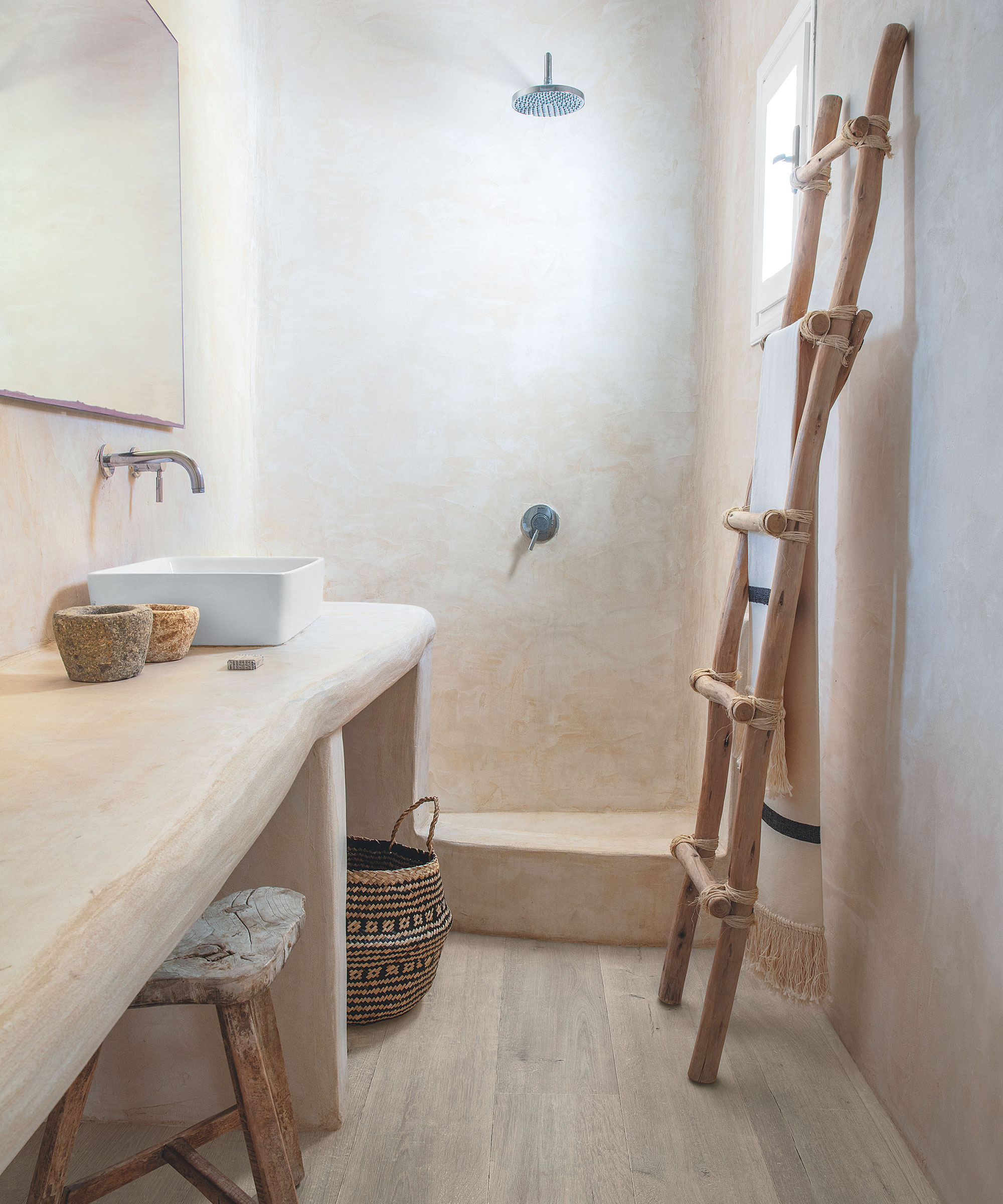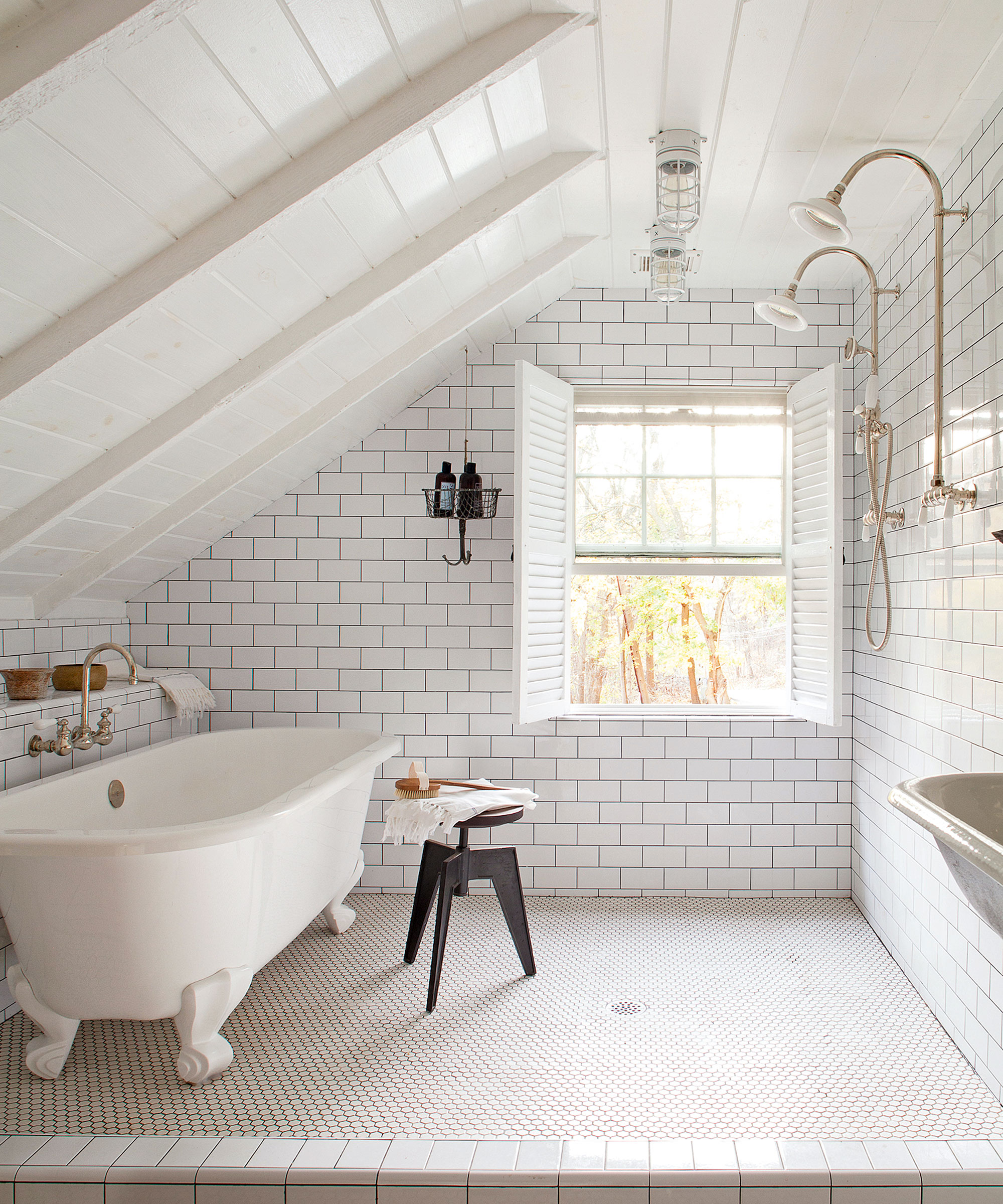Small wet room ideas – 10 compact bathroom designs for your home
These small wet room ideas and expert tips will inspire you to create a luxurious bathroom shower, even in a tiny space

- 1. Go for all-over plaster in a small wet room
- 2. Take a less is more approach
- 3. Go big on color when space is tight
- 4. Soften a small wet room with curves
- 5. Work the walls in a small shower room
- 6. Divide your small wet room
- 7. Combine a small wet room with a bathing area
- 8. Embrace a small room with a dark and dramatic approach
- 9. Invest in luxury bathroom materials
- 10. Make sure your small wet room is warm and ventilated
Small wet room ideas are becoming increasingly popular in bijou schemes, allowing for contemporary design without the need to squeeze in a shower enclosure or raised shower tray in your master bathroom or en suite.
Wet rooms provide a spacious showering area and the high-end look of a luxurious hotel spa, even if you're working with a compact space. They are also level entry, so easily accessible to all, not to mention hygienic and easy to clean.
Small wet rooms are a big project when it comes to your small bathroom ideas, but they can be the most effective use of space when square footage is tight. They are a far more luxurious option than trying to cram in a shower unit with a bulky enclosure. Plus, a small wet room’s seamless design makes it a great option for accessibility and future-proofing your home for years to come.
10 small wet room ideas designers always recommend
Small wet rooms add a truly luxurious, spa-like showering experience. From the tiles you introduce to the hardware finish and even the lighting, there are plenty of elements to play with to find the right design for your home. Here's how to achieve the best results when planning a small wet room.
1. Go for all-over plaster in a small wet room

,Hygienic, seamless, and extremely beautiful, polished plaster is a popular choice right now. In small wet rooms and walk-in shower ideas, polished plaster’s waterproof prowess and elimination of moisture-seeping joints is the big story.
Venetian plaster requires waxing to seal out water, but most micro-cements and Tadelakt plasters are inherently waterproof, not to mention stain-resistant, UV-stable and easy to clean.
The polished plaster look can be very sleek and contemporary, or more rustic for an earthy effect. Adding pigments allows customisable color, and most types of polished plaster are suitable for use on floors, walls, ceilings, and even furniture.
Design expertise in your inbox – from inspiring decorating ideas and beautiful celebrity homes to practical gardening advice and shopping round-ups.
2. Take a less is more approach

‘When choosing colors and materials for small wet rooms, less is more. Here, we deliberately reduced the palette and created a streamlined design to really bring the focus to the materials,’ explains Katie Lion, interior designer at Kitesgrove.
‘Natural marble is a quietly luxurious choice that instills a sense of sophistication and calm in any wet room. Its unique veining can be a simple but impactful way of bringing interest and layers to what is often a smaller space. We chose a brass finish for all the trims and fixtures to pick out the warm tones of the marble striations, helping it feel cohesive, elegant, and timeless.’
3. Go big on color when space is tight

Even in a small wet room, the openness of the space can often leave you feeling cold and exposed, even if the room is well-heated. Here, clever color blocking techniques demonstrate how you can break up a space, put the shower area in the spotlight, and add a much-needed dose of visual warmth.
Red tones promote coziness – the color here is Silestone’s earthy, Mediterranean shade Arcilla Red – and also work well with textural materials such as wood accessories and woven storage, especially in a smaller design.
‘Silestone surfaces come in a great range of colors and large format slabs so there will be minimal grouting to clean,’ adds Ross Stewart of Cosentino.
4. Soften a small wet room with curves

Tucking your small wet room into an alcove will contain splashing but, if space allows, a curved showering area is far more impressive. And you can still pop a robe hook nearby without risk of soggy towels.
‘Curves provide a cocooning environment that will help you unwind physically and mentally while you shower,’ says Mandarin Stone’s creative director, Louisa Morgan.
‘They also provide welcome relief to all the hard edges and surface finishes typically found in small spaces.’ The tile trend for stacking skinny tiles vertically makes creating soft curves easier; add a generous border in a darker shade at floor level to really accentuate the shape.
5. Work the walls in a small shower room

It goes without saying that the floor needs to be fully tanked, but what about the walls? Shower tile ideas – on every inch of your wall – can prove incredibly sterile, not to mention costly.
In this small wet room by Richstone Properties, the walls are only tiled where absolutely necessary, namely in the main shower area and above the basin, and the space feels much more inviting for this restrained approach.
Do install tiled or stone upstands rather than timber skirting boards to protect lower walls from water damage. Remaining surfaces can be painted in a moisture resistant paint, like satin or eggshell, and don’t forget decent extraction.
6. Divide your small wet room

In small wet rooms, it pays to divide the space into wet and dry zones. A tall metal-framed screen lends an industrial edginess to this striking design, while keeping water away from the beautiful marble-topped vanity.
Making a feature of this dividing point boosts the overall design, particularly the clever mix of fluted and plain glass. The former nods to mid-century industrialism, adding an element of privacy, and the latter lets in maximum daylight from the window beyond. Locating the shower controls well away from the showerhead is also a smart idea.
7. Combine a small wet room with a bathing area

‘Side-by-side showers are perfect for ensuite bathroom ideas that are designed for sharing,’ says Emma Joyce, brand manager at House of Rohl.
‘It’s often a feature you’ll find in luxury hotels and allows plenty of personal space while making a bold statement. Try pairing with a freestanding tub to enjoy the best of both worlds.’
In this small wet room by Leanne Ford Interiors, the floor has been raised to accommodate drainage pipes, with a stepped front. The entire space inside was then tanked and tiled, essentially creating a giant shower tray that keeps water completely contained. A great way to introduce more features to a small footprint.
8. Embrace a small room with a dark and dramatic approach

Don't be afraid to use a dark color in a small wet room. A good bathroom color scheme is essential for creating the look, feel, and design you want in your space – and you can use everything, from tiles and sanitaryware to accessories, to create a unique look.
Introducing a dark and dramatic hue will really lift your whole home, bringing this functional space in line with the rest of your decor. This scheme is a perfect example, where black floor tiles and gray textured walls create a moody yet inviting small wet room.
9. Invest in luxury bathroom materials

There are few materials that can create the feeling of a luxury bathroom design like marble can, even in a small space. 'What I love most about marble is the activity, veining, and coloration,' says interior designer Cara Woodhouse.
Elegant, timeless, and effortlessly beautiful, marble is usually used in small wet rooms to create a statement finish, and although it is an expensive investment, it is a look that will last a lifetime.
Marble bathroom ideas work wonderfully in small wet rooms, and because of the relatively small space, it is also cost-effective, too. However, consider the use of marble carefully for spaces where you are using it in swathes, because no slab of marble is the same as another.
10. Make sure your small wet room is warm and ventilated

It’s important to take extra steps with regard to heat, ventilation, and drying. No one wants to exit a small wet room onto carpeted rooms, nor do they want to shower in low temperatures, either.
A screen will help to contain major puddles, but underfloor heating and heated towel rails will also speed up drying, help prevent slip hazards, and make the whole space feel warmer. And, do consider all non-slip bathroom flooring options when at the initial planning stage.
Mechanical ventilation is a must and will help to clear the steam quickly. Look for models with intelligent humidity sensors that automatically boost when required.
Is a wet room a good for small bathrooms?
A wet room is a good idea for a small bathroom. There are lots of benefits to having a small wet room – from being able to utilize a tiny or awkward space where a bath or standard shower enclosure cannot fit, to future-proofing your home.
What is the smallest size needed for a wet room?
The smallest size usually recommended for a wet room measures a minimum of 3ft x 3ft.
According to the best bathroom designers, when planning a shower design for a small bathroom, there are a few aspects that may determine the space required. Will pipework be exposed or concealed? Do you need to install a glass panel to prevent other areas of the room from getting wet?
Plus, don’t forget that adequate ventilation must also be installed in line with building regulations to prevent mould and damp spots.
Small wet rooms are the perfect solution for a compact bathroom, giving the illusion of greater space and offering opportunities to curate luxurious walk-in shower ideas for small bathrooms.
Whether you've got an awkwardly shaped room you want to make the most of or a tiny bathroom with no space for a traditional setup, the openness and simplicity of a small wet room will instantly elevate it.

Jennifer is the Digital Editor at Homes & Gardens, bringing years of interiors experience across the US and UK. She has worked with leading publications, blending expertise in PR, marketing, social media, commercial strategy, and e-commerce. Jennifer has covered every corner of the home – curating projects from top interior designers, sourcing celebrity properties, reviewing appliances, and delivering timely news. Now, she channels her digital skills into shaping the world’s leading interiors website.

